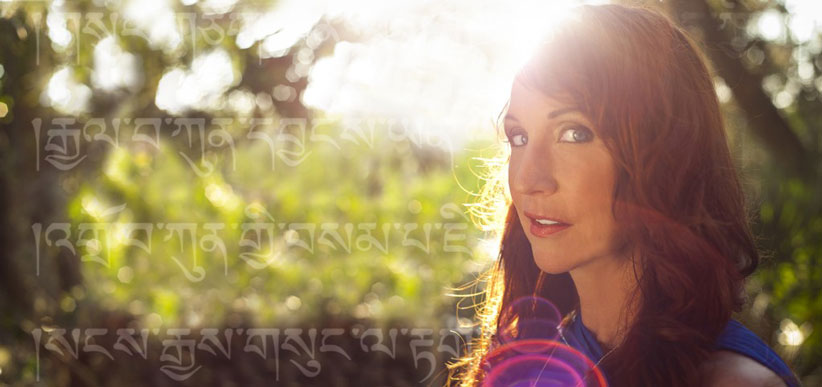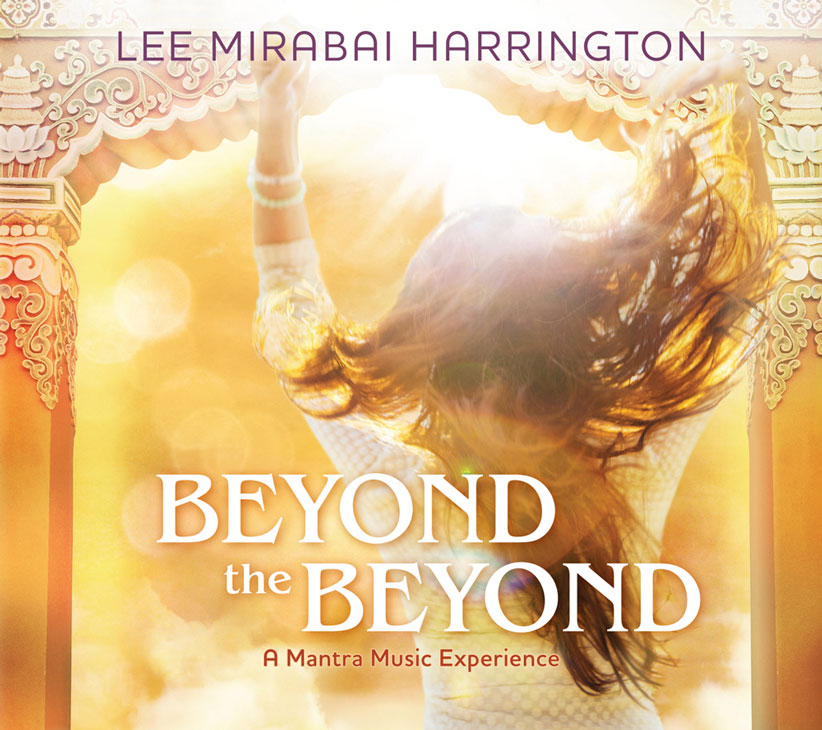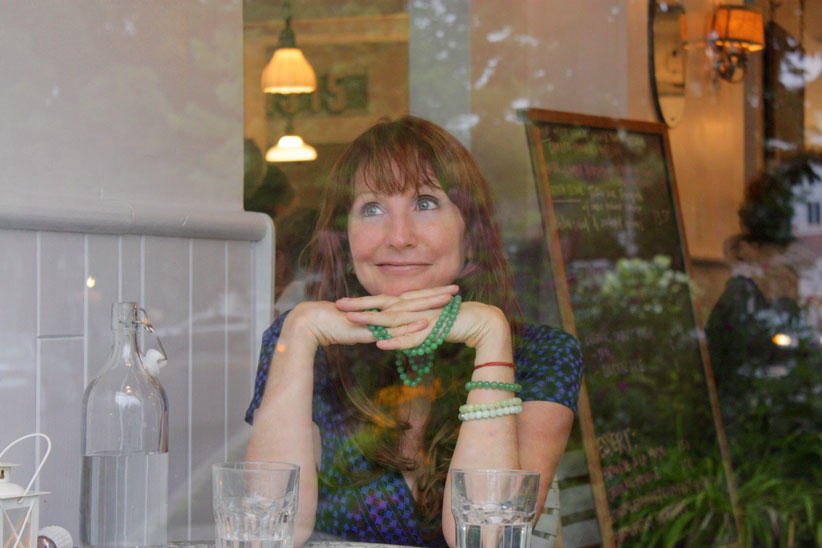I have been blessed to experience, in this lifetime, that all paths lead to one Truth. I enjoy living in this Truth and helping other people live it, too.

Photo of the artist by James K. Lindley
“Buddha Bhakta” Lee (Mirabai) Harrington is a Devotional Mantra Music artist based in New York’s Hudson Valley. A life-long spiritual seeker, she has been studying yoga since her teens and has been on the Mantrayana (Vehicle of Mantra) path of Buddhism since 2002. Her passion for—and commitment to—the healing power of mantras has led her to explore ancient mantras and chants from many other traditions, including Hindu, Sikh, Native American, Shamanistic, Taoist, Sufi and ancient Christian. This weekend, the Massachusetts native brings her mantra music back home to New England with live kirtan in Cambridge and Peabody. The tracklists for these two appearances will be brimming with songs from her new CD, BEYOND THE BEYOND. We caught up with the artist, fresh off of a silent retreat, at her home in Woodstock, New York.
Your music on Beyond the Beyond: A Mantra Music Experience so beautifully invokes the holy, the sacred. Can you tell us a bit about your rich spiritual background?
I’m glad to hear you picked up on the holy vibe of the album. In a nutshell, I’m a Tibetan Buddhist who practices Kundalini Yoga and Hatha yoga and follows the teachings of many Hindu gurus. I also connect strongly with the indigenous spiritualties: Native American, Peruvian, Celtic, etc. And, I also still honor the tradition I was born into in this lifetime – Christianity. I was named after Mother Mary – my middle name is the French Marie. All this is to say that I have been blessed to experience, in this lifetime, that all paths lead to one Truth. I enjoy living in this Truth and helping other people live it, too.
This brings to mind what the poet Rilke advises, to “live
Music, to me, is alive. Notes are living things…
Did your experience with gospel singing leave an imprint? If so, can you speak to how those vocal experiences inform your approach to interpreting devotional mantras today?
You can definitely feel a gospel influence in my kirtan music—especially on this album. The way I layer the calls and responses in two of my tracks (Om Tare Tuttare Ture Soha and Gate Gate Paragate Parasamgate Bodhi Soha) is very gospel. I’ve also always loved the “looseness” of a gospel chorus -the freedom, the unrestrained exaltation. You hear (and feel) this in the best of kirtan too. I use the word “feel” because music, to me, is alive. Notes are living things. My gospel choral director was always encouraging us to let spirit move through us; to let the music through us. I experience the same exact thing—at even more profound levels—with mantra music, because not only are we working with divine sounds, we are working with divine names and syllables, which are also alive with radiance and power. These days I am studying vocals with both a Classical Indian master and an opera coach, and I love this combination. In the morning I’m on Skype talking with my Indian master about the concept of gandharvas (celestial beings that, in my humble opinion, assist singers of sacred music), and in the afternoon I’m studying posture and technical finesse with this fantastic French-American opera diva. And having a gospel background serves both, because I always remember that as long as the spirit (or the gandharva) is moving through you, you’re on the right path.
That’s actually why I decided to leave some of the vocal “imperfections” in the final mix of the album. Here and there you’ll hear someone in the chorus who comes in half a second behind the group—that’s the “looseness” I mentioned above. It’s human. And therefore it’s alive.
Did Roger Daltrey really teach you how to belt?
There’s a long answer to this, but I’ll give you the shorter version… I grew up with four older brothers. So instead of listening to Madonna or girl bands, I grew up listening to and singing along with a lot of angry-white-male 70s album rock. As a result, I learned to sing by mimicking the way a man would sing. I had to unlearn all that, of course, and I’m not a belter anymore. But the experience really gave me a window into what it feels, and sounds, like to sing from the lower chakras. I’m certainly not saying that all male singers sing from the lower chakras, or that it’s wrong to do so, but for several years now I’ve been studying various modalities of sound healing, including vocal toning, Tibetan medical mantra, and mantrayana in general. I’ve gotten pretty good at recognizing who is singing from what chakra and/or from what emotional state. I was also blessed during the recording of BEYOND THE BEYOND to work with a producer who can see music and see what chakras are being activated by the music. With kirtan and mantra music and any kind of sacred music, I feel it’s important for the walla/walli to sing from the higher chakras and from the most exalted states of mind possible.
Nature offers us incredible music.
People just need to remember to turn their leaf blowers off.
Who would you cite as some of your other musical influences?
Right now, as in today, my influences are: the Sufi master Hazrat Inayat Khan, Eric Satie, Mozart and Pachelbel, Jimmy Page, Mirabai, Milarepa. I am also in love with my crystal singing bowls. Plus, all the birds and insects who are out there singing the songs of spring. My Buddhist training has taught me to see all sounds as sacred. Nature offers us incredible music. People just need to remember to turn their leaf blowers off.

A selection of tracks from Beyond the Beyond was released in honor of your teacher, His Holiness the 17th Gyalwang Karmapa’s, visit to the United States. Such an honor. Can you share with our readers a bit of how this arrangement came about?
I just love my precious teacher His Holiness the 17th Karmapa. He inspires in me a desire to do good, to serve, to be a Bodhisattva. So when I heard that he would be visiting the States—and, indeed, my own hometown of Woodstock, New York—in April of 2015, I decided to release an EP (literally “Early Pressing”) of the three Buddhist tracks we were in the midst of recording and editing for BEYOND THE BEYOND. On one level I just wanted to give something to someone I admire so much. I felt like the Little Drummer Boy. At most Buddhist pujas the offerings include sense offerings of incense, flowers, water, perfume and music, so offering His Holiness this music seemed appropriate. The EP is entitled INTO THE BEYOND, and it’s available for sale in limited edition through the Namse Bangdzo bookstore at Karma Triyana Dharmachakra monastery or through my website. All proceeds benefit the monastery and support His Holiness the 17th Karmapa’s mission to liberate all beings—including mother earth—from suffering.
I have to ask about the disco track… Shiva Shakti (Lord of the Disco Dance)? From where did that arrangement spring?
The energy of Shiva/Shakti is very powerful and also very danceable. The energy of that mantra makes you want to move. So it always made sense to me (and at the same time seemed to be a bit cheeky) to create a version of Shiva/Shakti with a disco influence. At the same time, I wanted to honor the Indian roots of the chant, so we asked saranghi maestro Hans Christian to integrate some Indian-influenced strings into the mix. The women from Kirtan Soul Revival join me in the chorus. I love the YouTube video, which features images of people of all shapes, sizes, colors and ages expressing their Shiva/Shakti dance moves.
Where can folks experience your music live? Are you presently on tour? Where does the rest of 2017 take you?
I have some physical limitations right now that prevent me from extensive “touring,” but I am offering some intimate kirtans in the northeast, where I live, from April through November. These take place at ashrams, dharma centers, yoga studios, etc. These live performances are definitely worth attending if you can. I’ll also be offering kirtan at a few festivals this year, including Shaktifest (May 2017) and Bhaktifest (September 2017) in Joshua Tree, California. After November I’ll be going to Florida, then India. It’s hard to predict, but fun to be in the flow.
Basically, I go where I am invited and I love playing at yoga festivals and retreat centers and holy places. But most of my spare time will be spent on retreat as I enter into my Magyu (the female/Mother lineage of Tibetan Buddhism) training program.
How do you capture the sacred quality of your recordings in your live kirtan?
This is an exciting question, because usually it’s the other way around. A lot of people have trouble capturing the sacred “bhav” aspect in their recordings. I’m so pleased to hear you say you felt a sacred quality in the recordings, because we worked very hard to make sure that sacred vibration was also first and foremost in the recording process. The short answer is that I always do an invocation and/or full puja before any live kirtan or any recording session. I always recite my refuge prayers and my personal guru-mantras. And then I get out of the way and let the divine emanations guide the process. That’s why I don’t like to use the word “performance” or “gig” when it comes to kirtan. A performance implies that people are coming to see me sing, whereas I’m up there making sure there is no “me” standing (or sitting) between the mantras, the deity energies and the people who come to experience them. It’s like St. Francis’s “make me an instrument.” And after every kirtan, or recording session, we dedicate the merit for the benefit of all sentient beings. That keeps the stream flowing.
Over the years, you have performed with a host of kirtan luminaries. What is your dream team duet? And if you had the opportunity to sing with that person(s), what song would you cover?
Ahh, dream duets… what a lovely question to think about. The first who comes to mind is His Holiness Karmapa, singing The 21 Praises to Tara. I’d also love to join Pete Townshend, singing his Now and Then or Bargain (which is actually a love song to Pete’s guru Meher Baba). On a more realistic level, I’d love to partner with the sublime Gurujass of White Sun. Both she and I share the dual connections to the streams of His Holiness Karmapa and Yogi Bhajan.
Don’t you want to live in a world where everyone has the capacity to love each moment and spend each moment in joy, in love, in art, in spirit?
Congratulations also on your success as an author. Can you speak a little about that balance of a “day” job and these dueling passions you pursue? As an artist myself, I walk a similar path. The “day” job affords me the window to write my poetry and make my pictures. But, the balance is an ongoing challenge for me. Are there insights you can offer in terms of accommodating both your lives – as a writer/teacher and also as a musician?
I agree that it can be a challenge, especially those of us who grew up with the “man can perfect the art or the life” adage, which I unfortunately read on a tea bag or something as a young and impressionable child…
My advice would be to try not to see the various aspects of our lives as “dueling” and/or in competition with our time, our energy, our passion. In Buddhism we try to practice something called “Right View” and as such one could view the term “dueling” as an aggressive view. But if we soften our view, and try to see ways in which our need to “make money” works in concert with our desire to create, express and uplift, we can experience an overall softening of that inner conflict of wanting to do something versus needing to do something. So instead of feeling we have to choose between work and art we start to view our work as part of our art. Indeed; our whole life can become art, or creative expression, or divine service, which are one and the same. This is also mindfulness in a nutshell.
This leads into my second bit of advice (which actually should be first)… offer everything you do to God or spirit or whatever you want to call this great benign essence. Dedicate every thought, word, action and deed to be of benefit to all sentient beings. That will also help lessen the amount of stress and inner conflict you might feel about having to work at a day job.
If you love what you are doing, and offer your task in service, you give your task wings. And things with wings have a better chance of reaching and uplifting other people.
And finally, don’t be a perfectionist about it. Whatever you are doing in the moment, love that. One of my favorite Rumi quotes is, “Let the beauty you love be what you do. There are hundreds of ways to kneel and kiss the ground.” Our capitalist culture has tried to convince us that it’s normal and even okay to be a drudge and hate your job, and that we should be content with these “after-work” rewards of sex, alcohol, television and video games, and even that we have to suffer in order to earn our “rewards.” But don’t you want to live in a world where everyone has the capacity to love each moment and spend each moment in joy, in love, in art, in spirit? In inspiration? Again, this is mindfulness boiled down to its essence. Years ago, while working at a Buddhist retreat center and consciously practicing mindfulness second by second, I discovered that even cleaning toilets is sacred. If you love what you are doing, and offer your task in service, you give your task wings. And things with wings have a better chance of reaching and uplifting other people.
As to how to balance a life where one practices multiple artistic “pursuits” (I love that word!)… I actually started writing music (non-secular) as a way to work through, or rather around, a period of writer’s block. I wanted to experience an art form that was immediate—where the means and the end are basically the same moment. Now that I’m fully immersed in music, with lots of kirtans on the horizon and a new album in the works, I find myself craving the writing life again, where the space between the means and the end is much longer and more languid. I feel that as long as we are tapped into our authentic self, we’re doing the right work.

Lee in her hometown of Woodstock, NY. Photo by Amber Roniger
Lastly, I often wrap up my chats asking if you might finish the following sentence?
I’d like to teach the world to… choose compassion. Do no harm. Help others. As His Holiness the 14th Dalai Lama says, “If you cannot help others, at least do not harm them.”
Sample Om Mani Pemi Hum Remix (Chenrezig’s Jam), by Lee (Mirabai) Harrington with this FREE DOWNLOAD!
Learn more about Lee (Mirabai) Harrington and her music through her website, www.leeharringtonmantramusic.com. And also on iTunes, Spotify, Spirit Voyage and YouTube. She will be sharing her kirtan live this weekend on Friday evening in Cambridge with the Kitchari Kirtan community and at Sanctuary Center for Yoga and Healing on Saturday evening.
Author Susan Currie is an Associate Editor at LA YOGA magazine. Her words and images have been featured in the Boston Globe, Elephant Journal, Yogi Times, the Tishman Review, the Huffington Post, Spirit of St. Bart’s and on the cover of the book Moving into Meditation (Shambala) by Anne Cushman.
Susan is also the creator of the Daily Inhale and an RYT 200 registered yoga instructor. She unpacks her various professional experiences through the creative and yoga workshops she leads throughout the country. Her new book, GRACENOTES (Shanti Arts 2017), a blend of words and images, is now available in wide release.
